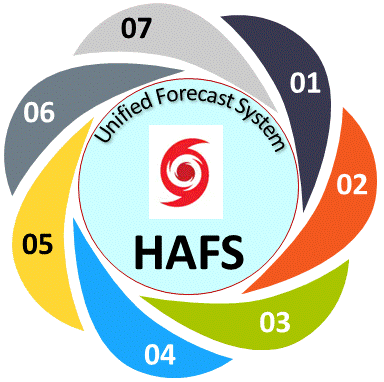OPERATIONAL IMPLEMENTATION
HAFSv1 FY2023 Operational Implementation:
- Highlights of HAFS Initial Operational Capability (IOC) implementation:
- Two HAFS configurations including HAFS-A (HFSA) and HAFS-B (HFSB) to
succeed the two legacy regional HWRF and HMON hurricane forecast systems,
respectively.
- First ufs-weather-model based regional hurricane forecast system (UFS
hurricane application), with Shared subcomponents (ufs-weather-model,
UFS_UTILS, GSI, UPP, etc.) and infrastructure (CMEPS, CCPP, etc.) with other
UFS applications.
- First UFS application with high resolution storm-following moving-nesting
capability using the regional Extended Schmidt Gnomonic (ESG) grid.
- Advanced and diversified CCPP-based physics suites for (HFSA and HFSB,
respectively) with optimized physics schemes for high resolution hurricane
forecasting.
- Modernized vortex initialization (VI) together with high-resolution
inner-core DA with 3-hourly FGAT, and 4DEnVar with GDAS ensembles. Meanwhile,
for the first time, use full DA increments in the storm inner-core region in a
NCEP operational regional hurricane forecast system.
- ESMF/CMEPS based HYCOM ocean coupling for all global TC basins with
extended ocean domains.
- Unified hurricane application workflow to support both research and
development Rocoto workflow and operational Ecflow workflow.
- Infrastructure and workflow:
- Use the HAFS production/hafs.v1 branch with the latest
submodules/subcomponents including ufs_utils, GSI, ufs-weather-model, UPP (as
of 01/17/2023)
- Storm-centric regional Extended Schmidt Gnomonic (ESG) grid based storm-following moving-nest configuration:
- HFSA: 6-km parent domain (1320x1200, ~78x75 degree) with a 2-km moving nest (600x600, ~12x12 degree)
- HFSB: 6-km parent domain (1200x1200, ~75x75 degree) with a 2-km moving nest (600x600, ~12x12 degree)
- Increased model vertical levels (L81) with a higher model top (2 hPa).
- Model physics time step of 90s (dt_atmos):
- HFSA: k/n_split of 2/4 for parent and k/n_split of 4/10 for nest
- HFSB: k/n_split of 2/4 for parent and k/n_split of 4/9 for nest
- Atmospheric initial condition and 3-hourly lateral boundary conditions from GFSv16, LBC blending with nrows_blend of 20.
- Using VIIRS vegetation type.
- Vortex initialization and data assimilation:
- Modernized vortex initialization (VI) including vortex relocation (VR) and
automatically determined vortex modification (VM) based on intensity
difference.
- HFSA: warm-cycling intensity threshold of 50 kt
- HFSB: warm-cycling intensity threshold of 40 kt
- High-resolution inner-core DA with 3-hourly FGAT, and 4DEnVar with 3-hourly
80 member GDAS ensembles.
- For the first time, use full DA increments in the storm inner-core region
in a NCEP operational regional hurricane forecast system.
- Updated adaptive observation error coefficients for flight recon data.
- Assimilate all the observation types ingested by HWRF and GFS/GDAS.
- Newly developed flexible HAFS DA tool for domain and storm merge to support
HAFS VI and DA needs.
- Dynamics:
- hord_mt/vt/tm/dp/tr=6/6/6/6/-5
- kord_mt/wz/tr/tm=11/11/11/-11
- Damping related options:
- tau=5, n_sponge = 24
- rf_cutoff = 50.e2, sg_cutoff = -1.
- d2_bg_k1=0.20, d2_bg_k2 = 0.15
- vtdm4 = 0.04, delt_max=0.008
- full_zs_filter=.true., and max_slope=0.15 for both parent and nest.
- Physics:
- HFSA: GFDL MP, RRTMG radiation (720s time step), modified TKE-EDMF GFS PBL
(sfc_rlm=1, d02 elmx/rlmx=250), upgraded sa-SAS CP (clam_deep=0.15), Noah LSM,
GFS SFC with HWRF exchange coefficients, unified UGWPv1.
- HFSB: Thompson MP, RRTMG radiation (1800s time step), modified TKE-EDMF GFS
PBL (tc_pbl=1, d02 elmx/rlmx=75), upgraded sa-SAS CP, Noah LSM, GFS SFC with
HWRF exchange coefficients, unified UGWPv1.
- Air-sea interaction and coupling:
- ESMF/CMEPS based HYCOM ocean coupling with extended HYCOM ocean domains
with 1/12-degree grid spacing and L41 vertical levels. Ocean IC from RTOFSv2
with persistent oceanic LBC. Atmospheric forcing from GFSv16 grib2 files for
non-overlapping area.
- One-way WW3 wave coupling for NHC/CPHC basins (NATL, EPAC, CPAC) for HFSA,
while no wave coupling for HFSB.
- Post-processing and products:
- Latest UPP.
- Upgraded GFDL vortex tracker.






